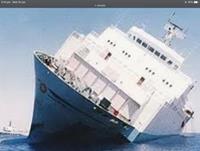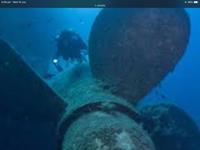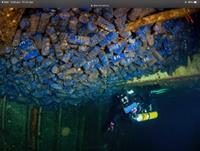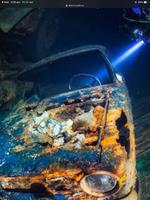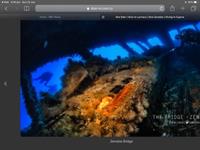DIVING THE WRECK OF THE ZENOBIA, CYPRUS By Andrew Falconer
I first heard about the Zenobia, while diving the many wrecks in Malta. Subsequently, then on the way to Crete, I decided to book return flights from Crete to Cyprus, and spend a week diving the wreck off Larnaca with Dive-in scuba Home | Dive-In Larnaca | Dive Zenobia | Diving in Cyprus and staying at the nearby Larco hotel http://www.booking.com/hotel/cy/larco-larnaca. In some ways the Zenobia can be compared to one of my favourite wrecks, the SS President Coolidge, in Vanuatu: it is similar in size (only 20m shorter and 2m narrower, and also rests on its port side). Unlike the Coolidge (20m to 80m) the depth is constant 22m to 42m from bow to stern, and the propulsion screws remain intact together with all the structure. The Zenobia has also been underwater approximately half as long as the Coolidge.
The Zenobia listing heavily to port prior to capsizing 8th June 1980 |
The Zenobia was a 12,000 tonne roll on / roll off ferry, built in Sweden and was on its maiden voyage, fully loaded when it capsized 1.5km off Larnaca on 8th June 1980, while en route to Syria. The vessel had trouble with its automatic ballasting system, causing it to list, which was corrected in Athens, but subsequently reoccurred near Cyprus, causing it to pull in to the port of Larnaca. The listing became worse and the captain was ordered to get out of the port as it was feared that it might sink and block the harbour. Sink it did, the next day as the crew abandoned ship approximately 1.5km offshore. The wreck was declared protected by the Cyprus government and as such has not been salvaged, and is completely intact, including its cargo of approximately 100 loaded semi trailer trucks. In the nearly 40 years since the ship went down, some marine life has made it their home, noticeably a significant number of groupers. The external hull and decks are covered with a thin layer of slimy marine growth, while inside most of the trucks fell over at various angles with the capsize, although at least one is still chained to the floor(now a vertical wall). Most of the trucks still contain their cargos, although some has spilled and in a few cases risen up to be trapped by the ships structure.
The impressive starboard screw |
I did ten dives (two per day) in total over five days. I had left my dive gear behind in Germany, so I had to hire everything, although the quality of the rental gear was very good. The water temperature was several degrees warmer than Malta (19 to 20 degrees) and I never felt cold with a full/shorty wetsuit combination. Also I was unable to take any photos, with the underwater shots in this article being sourced from the internet. However, I physically saw all the objects shown in the photos. The dive boat was a rib capable of carrying up to 18 divers, although fortunately this was never the case, and was powered by twin 300hp outboards, making the trip from the small boat harbour to the wreck site very quickly in about 3 minutes. Divers were in small groups, in my case only me and a guide/instructor, while some others were tech divers with all the gear. I dived initially on air with a 12l tank, then on nitrox with a 12l and finally nitrox with a 15l tank. The first day we stayed outside, covering the ship from bow to stern, including the impressive starboard propeller, rudder and external decks. The second day we penetrated the upper deck and the accommodation area where there was partial light entering from windows. Access was via a forward door, and exit amidships. Much of the accommodation area had collapsed since the walls were not steel, with loose floor coverings and a “no admittance” among other items seen. On the cargo there were many semi trailers, with cabs and different cargos, including 200litre drums, electrical panels and a mass of soft blue plastic bottles containing ethanol.
Soft plastic bottles trapped on the roof |
On the third day we penetrated the middle deck, via a doorway on the side of the hull, where it was pitch dark, except for our torches. This was the first time that I have ever dived in complete darkness with the only exit where we came in, quite some distance away, a situation not for everyone. There were also many trucks at various angles with with varying cargoes, as well as a forklift and a blue car (supposedly the captains).
The “captains” car inside the darkness of the middle deck |
On the fourth day, I did not have my personal guide, and had to repeat the dives of the second day, in the company of two other divers. This was a Saturday and there were considerably more divers from other boats on the wreck.
On the fifth and final day I got my personal guide back again, and we did two deeper (40m) dives namely the engine room and the chain locker/bridge, both excellent dives, which were just into deco limits.
Inside the bridge of the Zenobia |
In summary, in my opinion the Zenobia rates very highly, different but in many ways the equal of the Coolidge.
Costs were euros 640 (ten dives including hire of all equipment), euros 220 (seven nights accommodation), euros 140 (meals and drinks), total euros 1000 (excluding flights to/from Crete.
June 2019
 Northern Iceland
Northern Iceland Zenobia, Cyprus
Zenobia, Cyprus